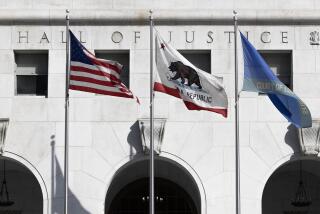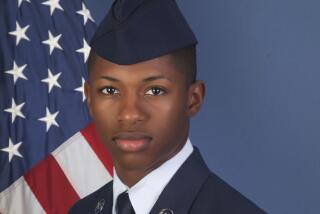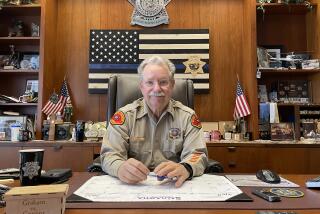Hospital’s Care of Deputy Probed : Slaying: Gunshot victim died at county’s King/Drew facility. Prosecutors say he may have received too much blood and fluids. Medical officials insist care was good.
The sound of taps has long faded from the cemetery where Los Angeles County Sheriff’s Deputy Nelson Yamamoto was buried last year after undergoing surgery for gunshot wounds.
But the case is far from closed. For 18 months, a high-stakes criminal investigation has quietly focused on whether Yamamoto’s death was caused by the gross negligence of doctors at Martin Luther King Jr./Drew Medical Center.
Although the county coroner concluded that Yamamoto died of gunshot wounds, the district attorney’s office is examining allegations that the deputy received excessive amounts of blood and other fluids and was given inappropriate cardiac drugs shortly before his death.
“We’re looking at the care that was provided (and) . . . whether it was a proximate cause of the deputy’s death,” said Deputy Dist. Atty. Brian Kelberg, head of the office’s medicolegal division, who is working with investigators from the California Medical Board and the sheriff’s homicide division. “Was it such an extreme departure from the standards of medical care to warrant a charge of involuntary manslaughter?”
Dr. James G. Haughton III, former medical director at King, said the physicians did their best to save the rookie deputy from very serious injuries to his groin and thigh. He said Yamamoto’s medical records have been reviewed by three local experts who agreed in confidential reports that the care met acceptable standards of practice.
“This is such a volatile situation,” said attorney William C. Moore of Beverly Hills, who is representing six doctors. “It’s a medical malpractice case with criminal consequences. It’s very very complex.”
The Yamamoto investigation has reverberated through the highest levels of county government. The sheriff, district attorney and a county supervisor have taken an interest in the case, which climaxed last week with the hospital’s vice chairwoman of surgery appearing before a criminal grand jury.
Now the county counsel has stepped in to defend the surgeon. And the family of the slain officer is preparing to file a malpractice lawsuit, based partly on facts unearthed by the investigation of Yamamoto’s medical care.
“My understanding is that it is very possible he’d be alive today but for mismanagement that took place,” the deputy’s father, Henry Yamamoto, said Thursday.
The investigation pits a beleaguered county hospital against watchdogs at the state medical board who have been accused of ignoring problems at King in the past.
This year, the state medical board reopened six cases at King after auditors charged that they had been closed prematurely. One case involved a patient with an ovarian cyst who died after a series of surgical mistakes summed up by the county coroner as a “therapeutic misadventure.” Another patient died after a hernia operation.
King officials said the 480-bed county teaching hospital just south of Watts has made great strides since 1989, when state health inspectors found serious patient care problems and federal officials threatened to withhold funding.
King’s administrator, Edward J. Renford, said the investigation into Yamamoto’s death is frustrating because “we’ve been working very hard at King to provide high quality service, and the reports and reviews that have been done show our success.”
*
The hospital is renown for its heavy load of trauma patients and a medical staff that is skilled at treating multiple gunshot wounds. The Army once sent doctors to train at King because the wounds treated there resemble combat injuries.
In Yamamoto’s case, his gunshot wounds were serious enough to cause death, even with excellent medical attention, the coroner’s office said. An autopsy found excess fluid in the deputy’s body and lungs but concluded that Yamamoto died from his wounds, which caused massive hemorrhaging leading to shock and lung damage.
Kelberg has challenged the coroner’s report, saying the deputy coroner lacked important information about Yamamoto’s care. The coroner declined to comment.
During the long investigation, top county officials, including Sheriff Sherman Block, have received periodic updates. County Supervisor Yvonne Brathwaite Burke, whose district includes the hospital, said she has discussed the investigation with Block and recently asked the office of the county counsel to advise the surgeon summoned by the grand jury.
Noting improvements in patient care at the hospital, Burke said she is confident there was “no intentional maltreatment or gross negligence” in Yamamoto’s death.
County health services director Robert Gates, who was briefed on the case several months ago by Dist. Atty. Gil Garcetti, said of the investigation: “It’s potentially extremely serious.”
At the vortex of the storm is Nelson Yamamoto, buried in April of 1992 with a hero’s funeral that drew nearly 4,000 uniformed officers from all over Southern California.
A healthy, 205-pound man with a boyish smile, he had been on patrol less than 60 days when he became involved in a shootout in Walnut Park the evening of March 29, 1992. The 26-year-old deputy was hit four times by an assailant, who days later would be killed by police in New York.
Wounded in the abdomen, thigh, shoulder and toe, Yamamoto was rushed by ambulance to King, the closest trauma center.
The officer was conscious and alert upon arrival, records show. Yamamoto’s father, Henry, said several weeks after his son’s death that he had been told his son was “calm and fearless” in the emergency room and was even “kidding around with the nurses.”
Forty-two hours later, after surgery, the deputy was dead.
At the time, no questions were raised publicly about his medical care.
But the Sheriff’s Department later received a complaint about Yamamoto’s treatment. When the information reached the state medical board, that agency asked the hospital in May, 1992, to turn over Yamamoto’s medical records. Sheriff’s officials have refused to discuss the source of their information.
Haughton, who left King in May of this year for another health department job, said he produced everything except a chest X-ray, which could not be found.
Since then, eight physicians, as well as nurses and paramedics, have been interviewed by Kelberg, with assistance from Dr. Eugene Kompaniez, a state medical board consultant and former surgeon at Cedars-Sinai Medical Center.
After being interviewed, the first few doctors “came back really shaken,” Haughton recalled. “They expressed concern about being there without legal representation.”
Haughton said he then asked the county counsel’s office to represent the King physicians but was refused. So the doctors hired a private attorney.
The attorney, Moore, said he objects to the interviews because the prosecutor repeatedly “insults the doctors with stupid questions.” He said that is why he terminated the recent interview with Dr. Rosalyn Sterling-Scott, who supervised Yamamoto’s postoperative care .
At this impasse, the district attorney resorted to use of a county grand jury summons, and Supervisor Burke asked the county counsel’s office to advise Sterling-Scott.
On Nov. 2, Sterling-Scott, now vice chairwoman of surgery, emerged from the grand jury room after about a half-hour.
Assistant County Counsel Peter Glick, who represented Sterling-Scott, said he does not know enough about the case to discuss it. Sterling-Scott did not return phone messages.
Haughton described Sterling-Scott as an excellent surgeon. Records show the county hospital and medical school pay her an annual salary of about $115,000, plus overtime amounting to about $20,000 last year.
Kelberg said he is examining the amount of time that Sterling-Scott, the attending physician in charge, was present during Yamamoto’s treatment. Records provided to the medical board indicate that she signed several medical prescriptions for Yamamoto but entered virtually no patient care notes. Other physicians provided written case summaries.
*
Another issue, Kelberg said, is why the staff did not summon a cardiologist to treat Yamamoto.
Haughton said he is “absolutely” sure that Sterling-Scott was present and tended expertly to Yamamoto because she briefed him on the case at the time. A cardiologist was unnecessary, he added, because Sterling-Scott specializes in heart surgery.
Two cardiac drugs--verapamil and labetalol--were administered by doctors shortly before Yamamoto’s death. Kelberg said he questions whether these drugs were appropriate.
Also under investigation, he said, is whether Yamamoto was over-transfused with blood and overloaded with fluids.
Attorney Moore said Yamamoto’s care should not be analyzed “piece by piece” but viewed as a whole. Overall, he said, the “best doctors for gunshot wounds in Southern California” did a commendable job trying to save a patient with critical wounds during more than eight hours of surgery where he was transfused twice. The chance of survival in such cases, he said, is low.
Kelberg said he is preparing to present the case for review to four independent medical experts including an anesthesiologist, a surgeon, a cardiologist and another specialist. Given the complexity of the case and the “mountain of material,” he estimated that experts will need at least two months to review the matter.
Among other things, experts will have to reconcile some apparent discrepancies in the medical records. A surgical resident wrote in an official summary of the case that Yamamoto arrived at King in extreme shock while emergency room records describe him as “alert and oriented,” with adequate blood pressure and other vital signs.
Kelberg said he believes the surgeons did a “first-class job” in repairing Yamamoto’s colon and intestine and tying off some blood vessels in his pelvic area and thigh. But he said he is concerned about the amount of blood and fluid Yamamoto received during surgery and afterward.
The deputy bled profusely in the operating room, but as he was losing blood, additional blood products and fluid were pumped in. In all, he lost an estimated 10 liters, or almost twice his total blood supply.
By the end of surgery, records indicate, he received far more blood and fluid than he lost. His hands, face, legs and scrotum were grossly swollen, and a chest X-ray showed fluid in the lungs, according to notes in the patient file.
“Because of the fear of over-transfusion,” about 1.5 liters of blood were drained from the deputy shortly after surgery, emergency medicine chief Dr. William C. Shoemaker said in a memo reviewing the case for Haughton in April, 1992.
In addition, multiple doses of highly concentrated albumin were given and a powerful diuretic Lasix was administered to drain off excess fluid, records show.
Nevertheless, his blood pressure and oxygen consumption dropped precipitously. About noon on March 31, the cardiac drugs verapamil and labetalol were administered. “The patient went into cardiopulmonary arrest from which he could not be resuscitated,” the memo states.
When contacted by telephone and asked about the memo, Shoemaker hung up, saying: “I don’t know what you’re talking about and I have no comment to make.”
Dr. Jake Davis, an anesthesiologist who treated Yamamoto, also refused to be interviewed about the case and hung up.
An autopsy found that Yamamoto’s body was overloaded with fluid and that he died of “adult respiratory distress syndrome.” Instead of being full of air, the lungs oozed fluid. In the space between each lung and the chest wall, which is supposed to be virtually empty, there was almost a quart of fluid, the coroner found.
*
Haughton said that experts have evaluated “all facets” of the medical care Yamamoto received and determined it was within acceptable medical bounds. “I have no idea what is driving this case,” he said. “It puzzles me.”
Dr. Reed Tuckson, president of the Charles R. Drew School of Medicine and Science, whose faculty serves as King’s senior physicians, declined to comment on the Yamamoto investigation. But he said: “I really am unhappy when people continue to try to put the hospital in a bad light. There are so many dedicated people doing work that nobody else wants to do.”
More to Read
Sign up for Essential California
The most important California stories and recommendations in your inbox every morning.
You may occasionally receive promotional content from the Los Angeles Times.










